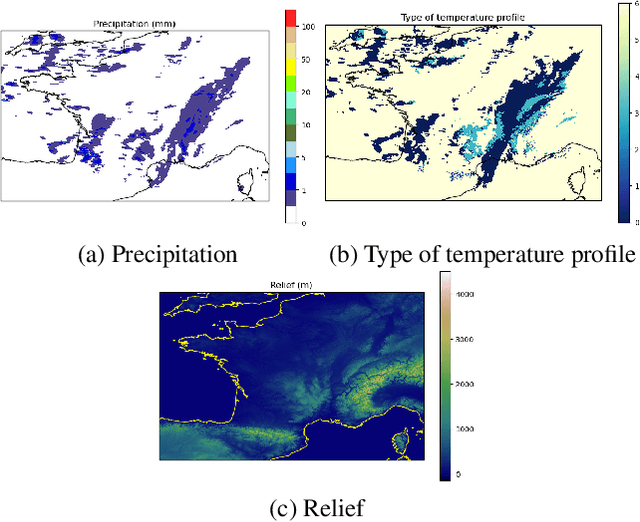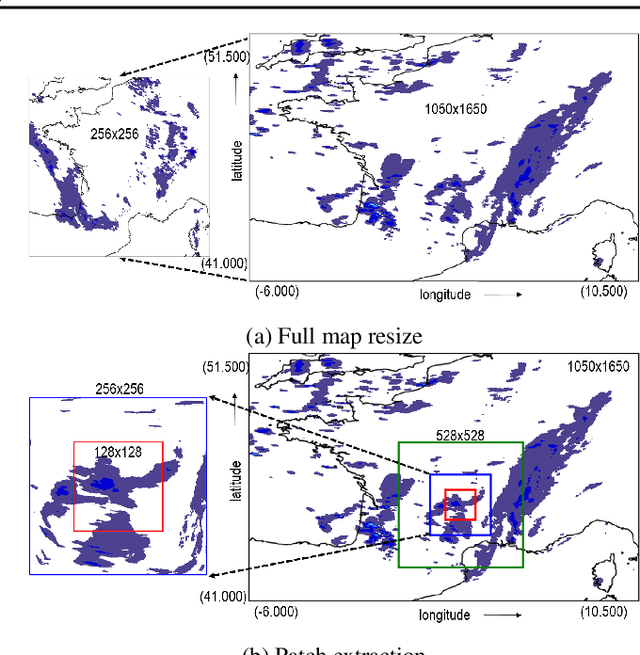Olivier Mestre
CNRM
Precipitaion Nowcasting using Deep Neural Network
Mar 24, 2022



Abstract:Precipitation nowcasting is of great importance for weather forecast users, for activities ranging from outdoor activities and sports competitions to airport traffic management. In contrast to long-term precipitation forecasts which are traditionally obtained from numerical models, precipitation nowcasting needs to be very fast. It is therefore more challenging to obtain because of this time constraint. Recently, many machine learning based methods had been proposed. We propose the use three popular deep learning models (U-net, ConvLSTM and SVG-LP) trained on two-dimensional precipitation maps for precipitation nowcasting. We proposed an algorithm for patch extraction to obtain high resolution precipitation maps. We proposed a loss function to solve the blurry image issue and to reduce the influence of zero value pixels in precipitation maps.
Sequential Aggregation of Probabilistic Forecasts -- Applicaton to Wind Speed Ensemble Forecasts
May 07, 2020



Abstract:In the field of numerical weather prediction (NWP), the probabilistic distribution of the future state of the atmosphere is sampled with Monte-Carlo-like simulations, called ensembles. These ensembles have deficiencies (such as conditional biases) that can be corrected thanks to statistical post-processing methods. Several ensembles exist and may be corrected with different statistiscal methods. A further step is to combine these raw or post-processed ensembles. The theory of prediction with expert advice allows us to build combination algorithms with theoretical guarantees on the forecast performance. This article adapts this theory to the case of probabilistic forecasts issued as step-wise cumulative distribution functions (CDF). The theory is applied to wind speed forecasting, by combining several raw or post-processed ensembles, considered as CDFs. The second goal of this study is to explore the use of two forecast performance criteria: the Continous ranked probability score (CRPS) and the Jolliffe-Primo test. Comparing the results obtained with both criteria leads to reconsidering the usual way to build skillful probabilistic forecasts, based on the minimization of the CRPS. Minimizing the CRPS does not necessarily produce reliable forecasts according to the Jolliffe-Primo test. The Jolliffe-Primo test generally selects reliable forecasts, but could lead to issuing suboptimal forecasts in terms of CRPS. It is proposed to use both criterion to achieve reliable and skillful probabilistic forecasts.
Forest-based methods and ensemble model output statistics for rainfall ensemble forecasting
Nov 29, 2017



Abstract:Rainfall ensemble forecasts have to be skillful for both low precipitation and extreme events. We present statistical post-processing methods based on Quantile Regression Forests (QRF) and Gradient Forests (GF) with a parametric extension for heavy-tailed distributions. Our goal is to improve ensemble quality for all types of precipitation events, heavy-tailed included, subject to a good overall performance. Our hybrid proposed methods are applied to daily 51-h forecasts of 6-h accumulated precipitation from 2012 to 2015 over France using the M{\'e}t{\'e}o-France ensemble prediction system called PEARP. They provide calibrated pre-dictive distributions and compete favourably with state-of-the-art methods like Analogs method or Ensemble Model Output Statistics. In particular, hybrid forest-based procedures appear to bring an added value to the forecast of heavy rainfall.
 Add to Chrome
Add to Chrome Add to Firefox
Add to Firefox Add to Edge
Add to Edge